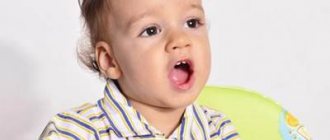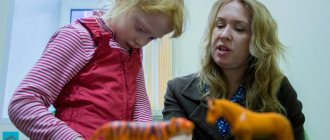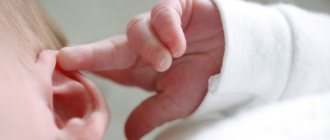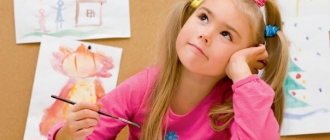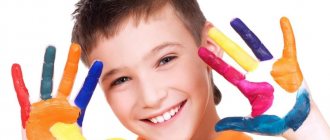Progress of the game
Gradually, the exercises can be complicated by adding new features of objects and expanding them.
You should put several animal toys in front of the child and describe them.
The fox is an animal that lives in the forest. The fox has red fur and a long tail. She eats other small animals.
A hare is a small animal that jumps. He loves carrots. The hare has long ears and a very small tail.
"How do you know?"
Goal: to develop in children the ability to select evidence when composing stories, choosing essential features.
Material: subject pictures .
Progress of the game
Children learn to write stories about professions.
The teacher gives an example: “This is a doctor. He heals people. He prescribes different medications for each patient. The doctor looks at the throat, listens, takes the temperature, gives injections.
Following the model, children make up short stories from the pictures about the profession of a salesman, hairdresser, pilot, etc.
"Proverbs, sayings"
Goal: develop logical thinking : the ability to observe, compare, analyze and draw conclusions; ability to work with words.
Progress of the game
The teacher suggests to the children: “Let's play. Let the objects in our room tell us about themselves, and we will guess from the description which object is speaking. We must follow the rules of the game: when you talk about an object, do not look at it so that we do not immediately guess. Talk only about the objects that are in the room.” After a short pause (children must choose an item to describe and prepare to answer)
The teacher places a pebble on the lap of anyone playing. The child stands up and gives a description of the object, and then passes the pebble to the one who will guess. Having guessed, the child describes his object and passes the pebble to another player so that he can guess.
Item description plan: It is multi-colored and round in shape. You can throw it up, roll it on the ground, but you can’t play it in a group, as it can break the glass.
“Describe and Guess”
Goal: to develop the ability to compose short stories of a creative nature on a topic proposed by the teacher. Develop a monologue form of speech .
Games and exercises for the development of coherent speech
Games and exercises for the development of coherent speech.
"Correct the mistake"
Target
: teach to see the discrepancy between the signs of familiar objects shown in the picture and name them.
An adult draws himself or shows a picture and invites the child to find inaccuracies: a red chicken pecks at a carrot; bear cub with hare ears; blue fox without a tail, etc. The child corrects: the chicken is yellow, pecking at grains; the bear cub has round small ears; The fox has a long tail and a red coat.
Compare different animals"
Target
: teach to compare different
animals
, highlighting opposite characteristics.
The teacher suggests looking at a bear and a mouse. - The bear is big, and the mouse... (small). What kind of bear... (fat, thick-footed, club-footed)? And what kind of mouse... (small, gray, fast, dexterous)? What Mishka loves... (honey, raspberries), and the mouse loves... (cheese, crackers). - Mishka’s paws are thick, and the mouse’s... (thin). The bear screams in a loud, rough voice, and the mouse... (in a thin voice). Who has the longest tail? The mouse has a long tail, and Mishka... (short). Similarly, you can compare other animals - the fox and the hare, the wolf and the bear. Based on visualization, children learn to name words with opposite meanings: the Katya doll is big, and Tanya... (small); the red pencil is long and the blue one... (short), the green ribbon is narrow and the white one... (wide); one tree is tall and the other... (low); Katya's doll's hair is light, and Tanya's... (dark). Children develop an understanding and use of general concepts (a dress, a shirt are... clothes; a doll, a ball are toys; a cup, a plate are dishes), develop the ability to compare objects (toys, pictures), relate the whole and its parts (locomotive, pipes, windows, cars, wheels - train). Children are taught to understand the semantic relationships of words of different parts of speech in a single thematic space: a bird flies, a fish... (swims); they are building a house, soup... (cooking); the ball is made of rubber, the pencil... (of wood). They can continue the series of words they started: plates, cups... (spoons, forks); jacket, dress... (shirt, skirt, trousers). On the basis of clarity, work is carried out and familiarization with polysemantic words (chair leg - table leg - mushroom leg; handle on a bag - handle on an umbrella - handle on a cup; sewing needle - needle on a hedgehog on its back - needle on a Christmas tree).
"Lay out the pictures"
Target:
highlight the beginning and end of an action and name them correctly.
Children are given two pictures depicting two sequential actions (Fig. 1) (a boy sleeps and does exercises; a girl has lunch and washes dishes; mother washes and hangs clothes, etc.). The child must name the actions of the characters and write a short story in which the beginning and end of the action should be clearly visible.
"Who knows how to do what"
Target
: choose verbs that denote the characteristic actions of animals.
The child is shown pictures of animals, and he says what they like to do, how they scream (Fig. 2). For example, a cat meows, purrs, scratches, laps milk, catches mice, plays with a ball; the dog barks, guards the house, gnaws bones, growls, wags its tail, runs. This game can be played on different topics. For example, animals and birds: a sparrow chirps, a rooster crows, a pig grunts, a duck quacks, a frog croaks.
"Who can name more actions"
Target
: choose verbs that denote actions.
— What can you do with flowers? (Tear, plant, water, look, admire, give, smell, put in a vase.) What does the janitor do? (Sweeps, cleans, waters flowers, clears snow from paths, sprinkles them with sand.) What does the plane do? (Flies, hums, rises, takes off, lands.) What can you do with the doll? (Play, walk, feed, treat, bathe, dress up.) For each correct answer, the child is given a colored ribbon. The winner is the one who collects ribbons of all colors.
“How can I say it differently?”
Target
: replace polysemantic words in phrases. - Say it differently! The clock is running... (running). The boy is walking... (walking). It's snowing... (falling). The train is coming... (riding, rushing). Spring is coming... (coming). The steamer is coming... (sailing). Complete the sentences. The boy went... The girl left... People came out... I came... Sasha walks slowly, but Vova walks... We can say that he is not walking, but...
Compiling the fairy tale “Masha’s Adventures in the Forest”
The teacher asks: “Why did Masha go into the forest? Why do they go to the forest at all? (Get mushrooms, berries, flowers, take a walk.) What could have happened to her? (I got lost and met someone.) This technique prevents the appearance of identical plots and shows children possible options for its development.
"Who has whom"
Target
: correlate the names of animals and their young, select actions to match the names of the animals.
The child looks at the drawings (Fig. 6) - animals with babies: a hen and chick pecking grains (or drinking water), a cat and kitten lapping milk (option - playing with a ball), a dog and puppy gnawing a bone (option - barking), cow and calf they nibble grass (option: moo), the horse and foal chew hay (option: gallop), the duck and duckling swim (quack). - Name the animals and their young. - Choose definitions for the names of baby animals: tell me which chicken (cat, dog, cow, duck, horse), which chicken (kitten, puppy, calf, foal, duckling)?
“Make a description”
Target
: teach children to describe an object, naming its characteristics, qualities, actions.
- Describe the berry or fruit that you love most, and we will guess. (“It’s round, red, juicy, delicious - it’s my favorite... tomato”; “It’s dark burgundy in color, and inside it has many, many different grains, sweet and ripe, this is my favorite fruit... pomegranate.”) Let's give an example. classes where all speech tasks are closely intertwined: education of the sound culture of speech, vocabulary work, the formation of the grammatical structure of speech and the development of coherent speech.
"Make up a story"
Target
: teach children to understand the figurative meaning of words and expressions, which change their meaning depending on phrases, and transfer them into a coherent statement.
- Finish the phrase:
1. The pillow is soft, and the bench... (hard). Plasticine is soft, and stone... (hard).
2. The stream is shallow, and the river... (deep). Currant berries are small, and strawberries... (large).
3. The porridge is cooked thick, and the soup... (thin). The forest is dense, and sometimes... (sparse).
4. After rain, the ground is damp, but in sunny weather... (dry). We buy raw potatoes and eat... (boiled).
5. We bought fresh bread, but the next day it became... (stale). In the summer we ate fresh cucumbers, and in the winter... (salted). Now the collar is fresh, but tomorrow it will be... (dirty).
- Explain how you understand these expressions: the rain was mischievous; the forest is dormant; the house is growing; streams are running; the song flows. — How to say it differently: evil winter (very cold); prickly wind (harsh); light breeze (cool); golden hands (they can do everything beautifully); golden hair (beautiful, shiny)? — Where have you come across the expression “evil winter”? (In fairy tales.) Who does the word “evil” refer to? (Evil stepmother, evil witch, evil Baba Yaga.) - Come up with a coherent ending to the phrases: “Little bear, where did you walk? (I was looking for honey on the tree.) Little bears, where have you been? (We walked through the raspberries into the forest, we wandered in the clearing.) The little bear was looking for honey (and lost his little brother).” - Come up with a story about two bear cubs, and I’ll write it down, then we’ll read it to dad (grandmother, sister).
Progress of the game
Children are invited to continue and complete the sentence started by the speech therapist, based on leading questions. For example, the teacher begins a sentence like this: “The children are coming. (Where? Why)
"Or a more complicated version:
"Children go to school to."
In addition to enriching grammatical experience, this option can serve as a kind of test to identify a child’s anxiety in relation to various life situations.
"If."
Goal: to develop in children coherent speech , imagination, higher forms of thinking - synthesis, forecasting, experimentation.
“Write a story” (for children 5-6 years old)
Each participant in the game receives a large card (based on the lotto principle), consisting of 8 pictures separated from each other by lines. They are located two in one row. The last picture of the previous row corresponds to the first picture of the next row. Children are also given a set of exactly the same individual (cut) pictures.
The teacher reads:
The cat loved sausages. The sausages were in the bag. The bag was guarded by a dog. The dog prevented the cat from stealing the sausages.
At first, children listen to the story based on a large card, then it is turned over, and the players “write down” the story using separate cut pictures, arranging them in the following order:
cat-sausages sausages-bag bag-dog dog-cat
Next, the players take turns telling, based on their plan, what they did. Then they discuss with the teacher whose story is more accurate. When children have mastered the principle of “recording,” they can listen to the next story without relying on a large card and try to “record” it immediately with separate pictures.
For example:
Sonya was eating candy. The dog smelled the candy. The dog opened the cupboard. There were sweets in the buffet.
Another version of this game can be a story invented by the child himself. He is asked to look at a large picture, the child “strings” one sentence onto another, covering its analogue on a large card with a separate picture. I use this game in subgroup classes, when two or three people can play at the same time.
Progress of the game.
The child is asked not only to compose a story based on the fairy tale using pictures , but also to restore their sequence. The pictures serve as a kind of outline for the story, allowing you to accurately convey the plot, from beginning to end. For each picture, the child makes one sentence and together they are connected into a coherent story .
"How do you know?"
Task: when composing a story, practice selecting evidence, focusing on the essential features of the subject being described.
Progress of the game. In front of the children are objects or pictures that they have to describe. The child chooses any object and names it. The presenter asks: “How did you know that this was a TV?”
The player must describe the object, choosing only the essential features that distinguish this object from the rest. For each correctly named attribute, he receives a chip. The one who collects the most chips wins.
“Write it up!”
Task: to train children in making sentences using a given verb.
Equipment. Flags, icons.
Description of the game. The teacher pronounces one word (verb, for example, “cooks”
.
Children come up with sentences with this word, for example: “Grandma cooks delicious pies
,
“The cook cooks delicious
,
“Tanya cooks soup
. Whoever has the most interesting offer gets a chip, a badge. The one with the most chips and icons wins.
Note. You can take more than just a verb as the basis of a sentence. The teacher can name any part of speech (adjective, adverb, etc. , depending on the purpose of the lesson.
“Which picture is not needed ?”
Goal: to develop in children the ability to find details that are unnecessary for a given story.
Main conclusions
By the end of preschool age, children should master the skills of coherent speech. The development of all aspects of coherent speech should be stimulated by various methods, using role-playing games, theatrical activities, speech sets of cards, didactic games for the development of logic, consistency and expressiveness, and mnemonics.
With regular use of these techniques, the child’s speech during the examination before entering first grade will be at a high level. Speech develops most quickly in play, the leading activity of preschool children.
If you liked the article, please share a link to it
Progress of the game
The child must explain the meaning of the proverb, saying, then repeat it clearly and expressively.
-Don’t have a hundred rubles, but have a hundred friends
– The day until the evening is boring if there is nothing to do
– Neatness makes a person beautiful
- A small task is better than any idleness
– If you chase two hares, you won’t catch either
“And I would...”
Goal: to develop creative imagination. Teach free storytelling.
Progress of the game
In front of the children are objects or pictures that they have to describe. The child chooses any object and names it. The presenter asks: “How did you know that this was a TV?”
The player must describe the object, choosing only the essential features that distinguish this object from the rest. For each correctly named attribute, he receives a chip. The one who collects the most chips wins.
"Is this true?"
Goal: to develop in children the ability to notice fables, illogical situations, and explain them; develop the ability to distinguish the real from the imagined.


